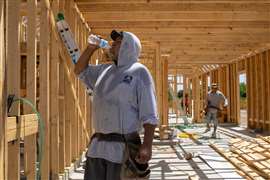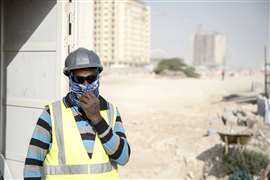Construction workers fight for emergency heat protection as temperatures soar
21 July 2023
Record-breaking temperatures in the US and Europe are intensifying the demand for rules protecting construction workers from extreme heat. Lucy Barnard finds out more.
A pair of weathered boots outside Houston’s City Hall on Friday 14 July honoured Filipe Pascual, a 46-year-old construction worker who collapsed at a job site in Fort Bend County, Texas during the “heat dome.”
Pascual, who according to the medical examiner’s office, was taken to Memorial Hermann Hospital Pearland after collapsing during a record-breaking heatwave in which Texas became one of the hottest places on earth, had been pouring concrete at Sienna Parkway and Waters Lake Boulevard in Missouri City and died from hyperthermia.
For the crowds in Houston, many wearing hard hats and holding hand-written placards scrawled in Spanish, news of Pascual’s death comes just as the state passed a law eliminating mandatory water breaks for construction workers in cities where local laws had been put in place to protect workers from extreme heat.
 Jesus Picasso, a builder originally from Mexico, takes a water break during hot weather in Manvel, Texas, U.S., July 13, 2023. REUTERS/Adrees Latif
Jesus Picasso, a builder originally from Mexico, takes a water break during hot weather in Manvel, Texas, U.S., July 13, 2023. REUTERS/Adrees Latif
“Las altas temperaturas provocan deshidratacion y golpes de calor,” (high temperatures cause dehydration and heat stroke) read one sign.
Texas’s controversial House Bill 2127 which was signed into law by Governor Greg Abbot in June effectively nullifies local ordinances passed in Austin in 2010 and in Dallas in 2015 which guarantee outdoor workers a break of at least 10 minutes every four hours to rest and hydrate – and prevents other cities in the state from passing similar rules.
Abbot and his supporters claim that the new law eliminates “a hodgepodge of onerous and burdensome regulations” for businesses. Critics argue it is little more than a power grab to stop local city councils passing regulations to protect workers.
“When I speak to people from other countries they just don’t understand how being able to drink water or take a break in the heat can even be an issue,” says Ana Gonzalez, deputy director of policy and politics at Texas AFL CIO, a federation of labour unions representing 240,000 members in Texas. “This bill is not only inhumane but dangerous.”
Gonzalez points out that union members already have rest breaks included in their contracts as part of collective bargaining agreements but says that it is non-union construction workers, many of whom are illegal or undocumented workers, who are most likely to suffer.
“It’s 107 degrees in Texas today,” she says. “These are record breaking temperatures. I’ve already had a call from a mother concerned her son is not getting the rest breaks he needs in this heat. This is an issue that needs to be dealt with urgently.”
And Texan construction workers are not the only ones campaigning to have heat recognized as an occupational hazard, especially for outdoor work such as construction.
Heat stress kills up to 2,000 US workers a year
Campaigners say that extreme heat is not only responsible for heat stroke and sun burn but is also likely to lead to greater incidents of falling, being struck by vehicles or mishandling machinery. US-based NGO Public Citizen estimated that heat stress can kill up to 2,000 workers and cause an additional 170,000 injuries on the job each year in the US alone, costing the US economy $100bn annually.
“The toll of unaddressed workplace heat stress on workers’ lives and well-being is immeasurable and unacceptable,” says Juley Fulcher, worker health and safety advocate with Public Citizen. “For every 1°C increase in temperate, workplace injuries rise by 1%, making heat stress prevention crucial.”
As temperatures around the world reached record highs this year in many parts of the USA, Europe, Australia, Asia, Africa and South America, unions are demanding “too hot to work” laws to protect construction workers and others from being forced to work in dangerously unhealthy temperatures.
Currently there are no heat-specific regulations mandated by the US Occupational Safety and Health Administration beyond a requirement that employers provide a workplace “free from recognized hazards” and recommendations for employers when temperatures reach above 91°F (33°C).
Moreover, only a handful of US states have implemented state-wide rules on the subject. California became the first US state to implement emergency rules to protect outdoor workers from extreme heat in 2005, requiring companies to provide employees with shade, water and rest when temperatures exceed 95°F (35°C). It was followed by Minnesota and Washington which have also implemented similar rules while Oregon, Colorado and Nevada passed their own codes last year.
Extreme heat prompts changes in Middle East and China
 A construction worker protects himself from the heat during building work at the Lusail Stadium, in Doha, 2019. Photo: Niklas Larsson / BILDBYRÅN/ Reuters
A construction worker protects himself from the heat during building work at the Lusail Stadium, in Doha, 2019. Photo: Niklas Larsson / BILDBYRÅN/ Reuters
One region where summer temperatures have been consistently high is the Middle East where summer temperatures regularly surpass 40°C (104°F) and where construction workers have been frequently exposed to extreme temperatures for the past two decades.
Investigations by human rights organisations such as Amnesty International suggest that extreme heat and unsafe working conditions caused the deaths of thousands of otherwise healthy migrant construction workers.
“When relatively young and healthy men die suddenly after working long hours in extreme heat, it raises serious questions about the safety of working conditions in Qatar,” says Steve Cockburn, Amnesty International’s head of economic and social justice. “This is a violation of the right to life.”
International diplomatic pressure has helped to prompt the UAE, Qatar and Saudi Arabia to introduce a system of summer working hours prohibiting outdoor construction work during the hottest parts of summer days. In the run up to the football world cup in Qatar in 2022, Qatar even extended its ban, preventing anyone working outside between the hours of 10am and 3.30pm between 1 June and 15 September.
In China, another country which has experienced extreme temperatures this year, regional governments are able to implement a summer high temperature allowance where employers unable to maintain a maximum working temperature must pay workers an additional cash allowance.
Yet many developed countries around the world are still playing catch-up with climate change.
Australia and New Zealand place no legal limits on the temperatures at which construction work can take place, although in both countries, employers have a duty of care to provide safe environments.
European regulations playing catch-up with climate change
In Europe too there is no overarching rules protecting construction workers from extreme heat. Most European countries too have no legal maximum working temperatures or heat protection regulations (although most include labour laws requiring workers to be comfortable or safe).
In Germany employers are required to ensure workers can proceed safely with their activities when temperatures exceed 26°C and provide drinkable water at 30°C. In Spain, the law says that work that requires light physical effort should be performed at between 14°C and 25°C.
Like many European governments, the UK has no maximum working temperature provisions. Last year the GMB Union, which represents workers from a range of sectors, called on the government to introduce “too hot to work” legislation at 27°C for those doing strenuous jobs and to be obliged to provide sun protection and water.
And, as global temperatures continue to rise, campaigners point out that it will be low-income workers around the world overwhelmingly bearing the brunt of any heat-related injuries.
The United Nations International Labor Organization predicts that heat stress linked to climate change is likely to lead to lost output equivalent to 80 million full time jobs – or 2.2% of total working hours worldwide during 2030 with poorer countries in West Africa and South East Asia worst affected.
“The impact of heat stress on labour productivity is a serious consequence of climate change,” says Catherine Saget, chief of unit in the ILO’s Research department. “We can expect to see more inequality between low and high income countries and worsening working conditions for the most vulnerable.”
CONNECT WITH THE TEAM









